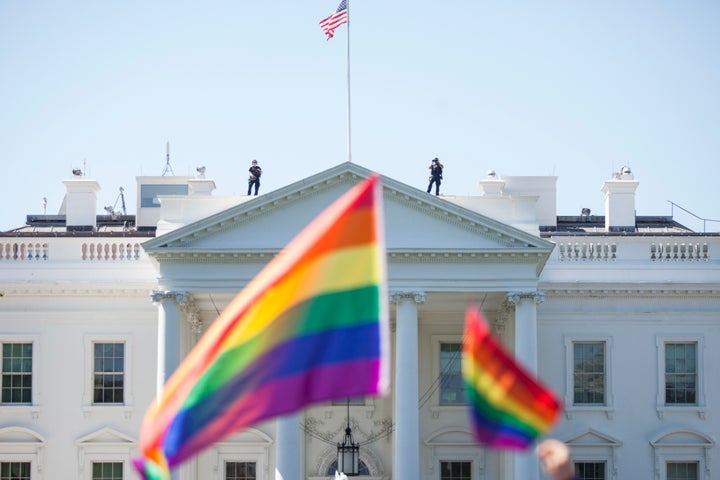
A 20-year-old man linked to a neo-Nazi group was charged last month in the brutal stabbing death of 19-year-old Blaze Bernstein, an openly gay Jewish college student who was reported missing by his family in Orange County, California, in early January and whose body was found in a wooded area.
Samuel Woodard, who allegedly stabbed Bernstein more than 20 times, is a member of the group Atomwaffen Division, ProPublica reported. Men with connections to the group have allegedly killed four other people across the country within an eight-month period.
HuffPost reporter Christopher Mathias described the Atomwaffen Division as “a well-armed neo-Nazi group enamored with Charles Manson and Adolf Hitler whose members harbor grand and demented delusions of fighting a ‘race war’ and overthrowing the U.S. government.”
In a recent report by the Anti-Defamation League, killings committed by white supremacists more than doubled in 2017. And hate-motivated homicides of LGBTQ people were up a whopping 86 percent nationwide in 2017 over the previous year, according to a report by the National Coalition of Anti-Violence Programs. Transgender women of color have consistently been the most targeted group among LGBTQ people, each year making up the highest number of hate-motivated killings.
Those numbers have been increasing dramatically. “In 2017, there were 27 hate-violence related homicides of transgender and gender non-conforming people, compared to 19 reports in 2016,” according to the NCAVP report. “[Twenty-two] of these homicides were of transgender women of color.”
And then there is the staggering statistic from the NCAVP report on murders of cisgender queer, gay or bisexual men: a 400 percent increase in hate-motivated homicides in 2017 ― from four in 2016 to 20 in 2017.
“Many men, whether they be white supremacists or not, have felt their masculinity threatened by the increased push for equality for LGBTQ people over the years.”
The great majority of these homicides, which include killers who lured their queer male victims using social media apps, weren’t committed by men involved with neo-Nazis or white supremacist groups. But those hate groups and their allies may feel emboldened by a president who talked about the neo-Nazi rally that took place in Charlottesville, Virginia, last year as having “very fine people” on “both sides.” And according to another ADL report, white supremacists hate groups are organizing on campuses, targeting college students. Those factors, in turn, have added to the culture of fear in which rising violence against LGBTQ individuals has taken place.
It is also appears to be true that many men, whether they be white supremacists or not, have felt their masculinity threatened by the increased push for equality for LGBTQ people over the years, as well as by the call for full equality for women, which the rise of the #MeToo movement both reflects and challenges. A study published last year showed that men who make sexist and homophobic jokes are the most insecure about their masculinity.
Much of the violence against gay and bi men and transgender women over the years has been committed by men who are deeply insecure about their masculinity and even sometimes about their own sexual orientation. Studies have shown that men most likely to harbor hate are often tormented themselves about their own same-sex attraction.
What may be different since 2017 is that these men ― and the vast majority of hate-motivated killings of queer people are committed by cisgender men ― now feel more empowered to act out. A GLAAD annual survey published in recent weeks found, for the first time in four years, a ”swift and alarming drop” in acceptance of LGBTQ people ― rather than the steady rise the survey saw each year prior ― and an increase in reports of discrimination by LGBTQ people:
The 2018 Accelerating Acceptance report found that 49 percent of the non-LGBTQ respondents identified themselves as LGBTQ “allies” in 2017, down from 53 percent in 2016. At the same time, 55 percent of the LGBTQ respondents said they experienced anti-queer discrimination last year, compared to 44 percent in 2016.
It’s hard not to see the connection between these recent changes and President Donald Trump’s actions. As I’ve reported and analyzed over the past year in several columns, Trump is the most anti-LGBTQ president in history, attempting to strip away hard-fought rights that have been won.
From banning transgender people in the military to advocating for allowing discrimination against gay, lesbian and bisexual people in employment, the Trump administration has brutally attacked LGBTQ rights by promoting religious exemptions.
Trump also put a man on the Supreme Court, Neil Gorsuch, whose judicial history shows a propensity to carve out religious exemptions to civil rights ― something which he has already demonstrated with recent dissents on the high court itself. As Trump stated in his first State of the Union address last week, his administration has “taken historic actions to protect religious liberty.” That was not-so-subtle code for clamping down on LGBTQ rights, directed squarely at his white evangelical base.
The aforementioned GLAAD survey likely doesn’t reflect that people have become more uncomfortable with queer people in the past year. Rather, it shows that in a climate in which the president of the United States actually privileges discrimination as a “liberty” people should enjoy, individuals who’ve always harbored that bias now feel more comfortable expressing it publicly.
Likewise, in this kind of hostile environment toward LGBTQ people, those who would engage in hate-motivated violence surely feel that there is a brisk wind at their backs.
Follow Michelangelo Signorile on Twitter: www.twitter.com/msignorile
